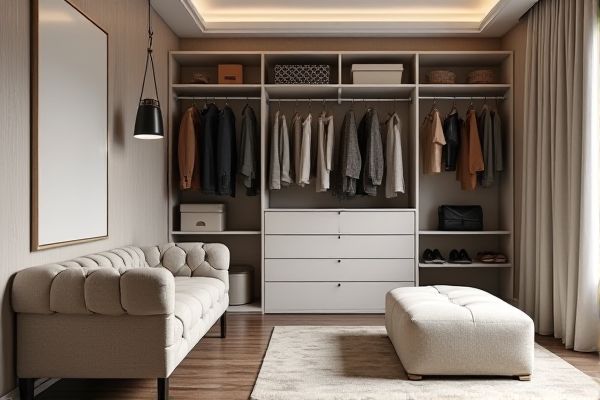
Closet benches offer sturdy seating with storage beneath, ideal for organizing shoes or accessories, while closet ottomans provide a softer, cushioned option that often doubles as a footrest. Discover which choice best enhances your closet's functionality and style by exploring the full comparison in this article.
Table of Comparison
| Feature | Closet Bench | Closet Ottoman |
|---|---|---|
| Primary Use | Seating area for dressing, shoe tying | Seating with additional storage inside |
| Storage | Limited or no storage | Built-in storage compartment |
| Design | Simple, slim profile | Chunky, upholstered design |
| Comfort | Basic padding or hard surface | Soft, cushioned surface |
| Space Efficiency | Smaller footprint, fits narrow spaces | Requires more space due to bulk |
| Cost | Generally more affordable | Usually higher price due to materials and storage |
Closet Bench vs Closet Ottoman: Key Differences
A closet bench typically features a sturdy frame with a flat top for seating and storage, making it ideal for organizing shoes or folded clothes. A closet ottoman, on the other hand, combines comfort with functionality, often including cushioned seating and hidden storage compartments perfect for soft items like scarves or accessories. Understanding these key differences helps you choose the best option for optimizing both space and style in your closet.
Space Efficiency: Bench or Ottoman?
A closet bench optimizes space by providing seating with built-in storage underneath, ideal for smaller closets where functionality meets organization. Closet ottomans offer versatile storage with a cushioned top, making them perfect for compact areas while doubling as a seat or footrest. Your choice depends on balancing seating comfort and maximizing storage within your closet's available space.
Comfort and Functionality Compared
Closet benches offer firm seating and often include built-in storage, making them ideal for organizing shoes or accessories while providing a sturdy spot to sit. Closet ottomans typically feature cushioned tops for enhanced comfort and may include hidden compartments, blending relaxation with discreet storage solutions. Your choice depends on whether you prioritize comfort during dressing or maximizing functional storage in your closet space.
Storage Capacity: Bench vs Ottoman
Closet benches typically offer more substantial storage capacity with built-in compartments or lift-up seats ideal for organizing shoes, accessories, or seasonal items. Closet ottomans, while stylish and versatile, generally provide less storage space due to their compact and cushioned design. Choosing between the two depends on the specific storage needs and available space within your closet.
Design Styles for Benches and Ottomans
Closet benches often feature sleek, minimalist designs with clean lines and built-in storage, ideal for modern or contemporary spaces, while closet ottomans tend to showcase plush upholstery and rounded edges, complementing traditional or transitional styles. You can select a bench with wood or metal accents to enhance a rustic or industrial closet, whereas ottomans might incorporate tufted details and soft fabrics for a luxurious, cozy feel. Both options offer versatile design styles that can be tailored to match your closet's aesthetic and functional needs.
Installation and Placement Tips
Closet benches typically require secure installation against a wall to ensure stability, making them ideal for long-term placement in larger closets or dressing rooms. Closet ottomans are freestanding and versatile, allowing you to easily move them around your space, perfect for smaller closets or multifunctional use. Consider your closet layout and available space to determine whether a fixed bench or portable ottoman better suits your storage and seating needs.
Material and Durability Comparison
Closet benches are often crafted from solid wood or metal frames with padded fabric or leather tops, offering durability and sturdy support for daily use. Closet ottomans, typically upholstered in softer fabrics like velvet or linen with foam cushioning, prioritize comfort but may show wear faster than benches made with hardwood. Choosing the right material ensures your storage seating withstands frequent use while complementing your closet's aesthetic and durability needs.
Cost and Budget Considerations
Closet benches generally cost more than closet ottomans due to their larger size and more durable construction materials, making them a better long-term investment for those prioritizing durability. Closet ottomans offer a budget-friendly option with a smaller footprint and often lighter materials, ideal for tight spaces or temporary use. Evaluating the initial purchase price alongside expected longevity helps balance cost-effectiveness with functional needs.
Best Uses: Bench or Ottoman for Your Closet
A closet bench provides a sturdy seating option ideal for dressing tasks, putting on shoes, or folding clothes, enhancing functionality in larger walk-in closets. In contrast, a closet ottoman offers versatile storage space with a cushioned top, perfect for holding accessories or linens while serving as a comfortable spot to sit. Choosing between a bench and an ottoman depends on the need for either extra seating or concealed storage to optimize closet organization and efficiency.
Choosing the Right Option for Your Closet
A closet bench offers sturdy seating with added storage space, ideal for organizing shoes or accessories in your closet. A closet ottoman provides a softer, versatile seating option with hidden storage, perfect for smaller spaces or adding a touch of comfort. Consider your closet's size, storage needs, and style preferences to choose the right option for your closet design.
 homyna.com
homyna.com